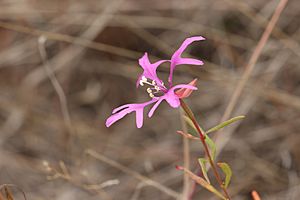Pinkfairies facts for kids
Quick facts for kids Pinkfairies |
|
|---|---|
 |
|
| Scientific classification | |
| Genus: |
Clarkia
|
| Species: |
pulchella
|
Clarkia pulchella, also known as pinkfairies, ragged robin, or deerhorn clarkia, is a beautiful flowering plant. It belongs to the Onagraceae family, which includes many types of evening primroses. This plant is famous for its unique flowers and its role in a big scientific discovery.
Contents
What Does Clarkia Pulchella Look Like?
Clarkia pulchella is a plant that grows from a soft stem, not a woody one. It can grow between 10 and 50 centimeters (about 4 to 20 inches) tall. The plant often stands straight up and might have branches. Its stems and leaves are covered with tiny, soft hairs.
Leaves and Flowers
The leaves grow along the stem and are shaped like a spear or a spoon. They are usually 2 to 7 centimeters (about 1 to 3 inches) long. Sometimes, their edges have small teeth.
The flowers are very special. They are usually lavender to light purple. Each flower has four main parts, called lobes, which are joined at the bottom. What makes them unique is that each of these four lobes is then split into three smaller parts. The middle part of each lobe is the widest.
Where Does Clarkia Pulchella Grow?
Clarkia pulchella is found in the Pacific Northwest region of North America. You can mostly see it east of the Cascade Range mountains. This includes parts of Washington, Oregon, Idaho, southern British Columbia in Canada, and the far west of Montana.
Plant Habitats
This plant can grow in many different places. It lives at various heights, from about 2000 to 5000 feet (600 to 1500 meters) above sea level. You might find it in forests, rocky areas, grasslands, or even in places where the ground has been disturbed.
How Was Clarkia Pulchella Discovered?
Clarkia pulchella was first discovered by Meriwether Lewis during the famous Lewis and Clark Expedition. He found it near Kamiah, Idaho in Idaho in 1806. Lewis collected a sample of the plant to bring back for study.
Naming the Plant
Even though Lewis found it, the plant was officially named Clarckia pulchella in 1814 by a botanist named Frederick Traugott Pursh. He named it in honor of William Clark, Lewis's partner on the expedition. This was the very first plant to be placed in the new group of plants called Clarckia. Later, the name of the group was changed slightly to Clarkia.
Bringing it to England
Years later, in 1826, another botanist named David Douglas collected more samples of Clarkia pulchella. He brought them all the way back to England after his trip to the northwest United States.
Clarkia Pulchella and Brownian Motion
Clarkia pulchella is most famous for its connection to a big scientific discovery. A botanist named Robert Brown used its pollen to discover something called Brownian motion.
What is Brownian Motion?
In 1827, Brown was looking at Clarkia pulchella pollen under a microscope. The pollen grains contain tiny, oblong particles. He noticed that these tiny particles were constantly jiggling and moving around in the water, even though nothing was pushing them. This random movement of particles in a fluid is now known as Brownian motion. It helped scientists understand that matter is made of tiny, constantly moving atoms and molecules.
Other Uses of the Plant
Scientists have also used Clarkia pulchella in other studies. For example, researchers Newman and Pilson used it to show how differences in genes within a group of plants can help that group survive.
Images for kids


